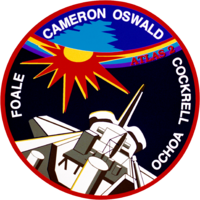STS-56
 | |
| Dane misji | |
| Indeks COSPAR | 1993-023A |
|---|---|
| Zaangażowani | |
| Oznaczenie kodowe | STS-56 |
| Pojazd | |
| Wahadłowiec | |
| Załoga | |
 L-P: Kenneth Cockrell, Stephen Oswald, Michael Foal, Kenneth Cameron i Ellen Ochoa. | |
| Dowódca | |
| Start | |
| Miejsce startu | |
| Początek misji | 8 kwietnia 1993, 05:29:00 UTC |
| Orbita okołoziemska | |
| Apogeum | 299 km |
| Perygeum | 291 km |
| Okres orbitalny | 90,4 min |
| Inklinacja orbity | 57,0° |
| Lądowanie | |
| Miejsce lądowania | |
| Lądowanie | 17 kwietnia 1993, 11:37:18,6 UTC |
| Czas trwania misji | 9 dni, 6 godz, 8 min, 19 sek |
| Przebyta odległość | 6 202 406 km[1] |
| Liczba okrążeń Ziemi | 148[1] |
| Program lotów wahadłowców | |
STS-56 (ang. Space Transportation System) – szesnasta misja wahadłowca kosmicznego Discovery i pięćdziesiąta czwarta programu lotów wahadłowców[2].
Załoga
- Kenneth Cameron (2)*, dowódca
- Stephen Oswald (2), pilot
- Michael Foale (2), specjalista misji 1
- Kenneth Cockrell (1), specjalista misji 2
- Ellen Ochoa (1), specjalista misji 3
- *(liczba w nawiasie oznacza liczbę lotów odbytych przez każdego z astronautów)
Parametry misji
- źródło[1]
- Masa:
- startowa orbitera: 107 346 kg
- lądującego orbitera: 93 826 kg
- ładunku: 7441 kg
- Perygeum: 291 km
- Apogeum: 299 km
- Inklinacja: 57,0°
- Okres orbitalny: 90,4 min
Cel misji
Lot poświęcony badaniom atmosfery ziemskiej przy pomocy zestawu aparatury ATLAS-02[2].
Zobacz też
Przypisy
- ↑ a b c Mark Wade: STS-56 (ang.). W: Encyclopedia Astronautica [on-line]. [dostęp 2017-07-25].
- ↑ a b c Tomáš Přibyl: Dzień, w którym nie wróciła COLUMBIA. Bielsko-Biała: Wydawnictwo >DEBIT<, 2003, s. 167. ISBN 83-7167-224-1.
- ↑ Robert Godwin: Space Shuttle. Warszawa: Prószyński Media Sp. z o.o., 2011, s. 67, seria: Historia podboju Kosmosu. ISBN 978-83-7648-973-5.
Linki zewnętrzne
- podsumowanie misji STS-56 na stronie KSC (ang.)
- Mark Wade: STS-56 (ang.). W: Encyclopedia Astronautica [on-line]. [dostęp 2017-07-25].
- Spaceflight mission report: STS-56 (ang.). Spacefacts. [dostęp 2017-07-25].
Media użyte na tej stronie
The flag of Navassa Island is simply the United States flag. It does not have a "local" flag or "unofficial" flag; it is an uninhabited island. The version with a profile view was based on Flags of the World and as a fictional design has no status warranting a place on any Wiki. It was made up by a random person with no connection to the island, it has never flown on the island, and it has never received any sort of recognition or validation by any authority. The person quoted on that page has no authority to bestow a flag, "unofficial" or otherwise, on the island.
STS-56 Mission Insignia
The STS-56 crew portrait includes five astronauts. Seated from the left are Stephen S. Oswald, pilot; and Kenneth D. Cameron, commander. Standing, from the left, are mission specialists Kenneth D. Cockrell, C. Michael Foale, and Ellen Ochoa. The crew launched aboard the Space Shuttle Discovery on April 8, 1993 at 1:29:00 am (EDT) with the Atmospheric Laboratory for Applications and Science-2 (ATLAS-2) as the primary payload.


